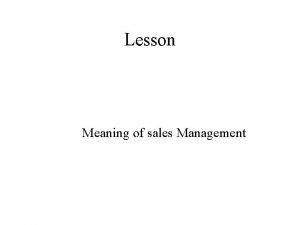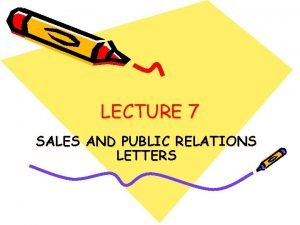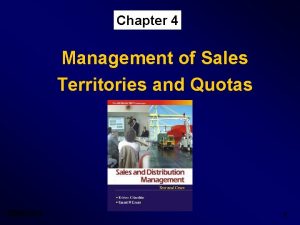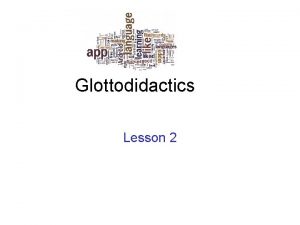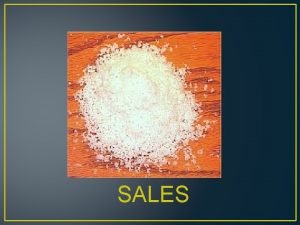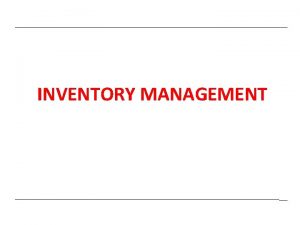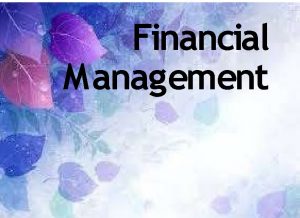Lesson Meaning of sales Management Sales Management as































- Slides: 31

Lesson Meaning of sales Management

Sales Management as defined by: - Sales Management is planning, direction, and control of personal selling including recruiting, selecting, equipping, assigning, routing, supervising, paying and motivating the sales force.

Objectives of Sales Mgmt. : - achieve- Sales volume/targets - Contribution to profits - Continuing growth - Top management delegates - Marketing Mgmt. Further delegates to Sales Management

Sales Management – Cont’d. . Sales Executives as Coordinator: - - Production Department –sales deptt. - Advertising Department-sales deptt. Sales Department - HRD-sales deptt. Coordinating with Advertising Marketing Advertising Sales

summary • Sales management is a core function of any sales organisation , be it into product selling or selling of services. It is this function which brings in revenue and profits to the sales organization , rest all other are cost to the company.

Thanks

Lesson Selling process & Theories of selling

Sales Management – Cont’d. . What is Personal Selling? Involves – oral conversations, either by telephone or face to face, between sales persons and customers. Contribution to Personal Selling: • Sales generate revenue • Sales people provide market research and customer feedback • Sales people provide solutions to problems • Sales people provide expertise and serve as information resources • Sales people serve as advocates for the customer when dealing with the selling organization. The four sales channels: • Field selling • Tele marketing • Inside selling – relying on phone, mail, e-commerce.

Sales & Distribution Management –Cont’d. . Personal Selling Processes Learning objectives: • To understand about the steps in personal selling process • To know the mistakes that can be done in sales. Steps in Personal Selling Process • Consists of creating new customers, and maintaining existing customers. Sales people follow a series of steps in identifying prospects and turning them into customers. The Sales Cycle 1. Prospecting Compensation 6. Follow up Appointment making 2. Pre-approach 3. Presentation 5. Closing the sale 4. Negotiations & handling objectives

Sales & Distribution Management Theories of Personal Selling: A) Is selling an `Art’ or a `Science’. B) AIDAS Theory of Selling: where, Satisfaction A = Attention I = Interest Actions D = Desire A = Action Desire & S = Satisfaction Interest Attention

Sales & Distribution Management –Cont’d. . C) “Right set of circumstances” Theory of selling. “Situation – response, theory. ” D) “Buying Formula” Theory of selling. need (or problem) Solution Purchase need product end/or trade purchase satisfaction/dissatisfaction or service Adequacy problem Need or problem Product Service Pleasant Feeling and/or trade name Pleasant Feelings Purchase satisfaction

Sales & Distribution Management –Cont’d. . E) “Behavioural Equation” Theory: B = P x D x Kx. V where, B = Response or the internal response tendency, that is the act of purchasing a brand or patronizing a supplier. P = Predisposition or the inward response tendency, that is, force of habit. D = Present drive level (amounts of motivation) K = “Incentive potential”that is, the value of the product or its potential satisfaction to the buyer. V = Intensity of all cues: triggering, product or informational.

Summary • Selling process involves methodologies step by step in getting closer to your client and achieving the sales objectives by successfully selling the products and services to clients.

• Thanks

lesson • Direct selling vs Indirect selling

Direct selling • It means when product or service is being sold directly , face to face or one –to-one to an individual consumer. Many times middlemen are eliminated and sales persons directly deal with end consumers.

Direct selling methods • • Database marketing Telemarketing Cold calling Referral marketing Sales promotion Networking presentations

Indirect selling • Selling where sales organzations use channels of distribution to sell their products or services. They do not sell directly to end consumers rather use middlemen to sell their products and services. Middlemen are known as customers.

Indirect selling • Most of the consumer durable firms and FMCG companies use indirect selling as their medium to sales. CRM is a major tool in success of indirect selling along with good advertising , brand management, and decent profit margins.

summary • Direct selling and indirect selling are the two methods to sell the products and services in open market and reach millions of consumers. It depends upon the nature of products and services that which method they adopt to sell.

• thanks

lesson • Main tasks in sales management

Sales & Distribution Management –Cont’d. . Tasks involved in Sales Management • Determining and achieving firm’s personal selling objectives • Formulating sales policies • Structuring the sales force • Designing sales territories • Developing sales forecasts and sales budgets • Fixing sales quotas/targets for individual sales territories/salesmen Creating the sales force - selection - recruitment - induction/orientation

Sales & Distribution Management –Cont’d. . Managing the sales force - Compensation - Motivation - Morale building - Sales coaching/supervision - Evaluation/Appraisal - Training & Development • Managing the marketing channels • Ensuring growth and developing new accounts • Sales communication & report writing • Sales coordination and sales control, including sales expense control • Building sales organization • Assisting market management in aspects like product mix, pricing, distribution, advertising and sales promotion • Creating and maintaining the right image for the company and its products in the market.

Sales & Distribution Management –Cont’d. . Areas where personal selling objectives have to be set: • Sales volume and sales growth • Share of each product in the total volume • Market share • Profits • Selling expenses • Key accounts • New accounts • Addition of new dealers and expansion of channel • Proportion of cash & credit sales • Collection of sales proceeds/amounts due • Pre sale and after sales service • Training of dealers & customers • Assistance in sales promotional measures • Supplying market intelligence

Sales & Distribution Management –Cont’d. . Areas where sales policies have to be set: Product - Appraising the product line on a regular basis and effecting necessary rationalization and improvements. • Which products should find a place in the product line • Whether some of the existing products are to be dropped • Whether any new products are to be added • Whether product design or product quality needs to be changed • What models, size, colours and packing are to be sold • How product service is to be provided • What kind of product guarantees are to be given

Sales & Distribution Management –Cont’d. . Distribution • Channel design and channel types • Channel remuneration, motivation and training • Channel- principal relations. • channel costs Pricing • Whether prices should match competition or whether those should be above or below competition • Pricing method to be followed for each class of customer or order • Discounts and rebates to be given • Teams of delivery/dispatch and terms of payment.

Sales & Distribution Management –Cont’d. . Topics to be discussed: 1. Structuring the sales force 2. Deciding sales force size 3. Designing sales territories a) What is a sales territory? b) Why sales Territory size territories? Territory shape

Sales & Distribution Management –Cont’d. . 4. Reviewing territory design 5. Assigning right territories to right salesman 6. Maintaining database on territories

summary • This lesson will help you in understanding the activities of sales management as an activity , It is an independent activity and thus a separate department in any sales organisation which is mainly responsible fo selling of its products and services.

• thanks
 Force management definition
Force management definition Sales management meaning
Sales management meaning Product sales force structure example
Product sales force structure example Difference between sales letter and sales promotion letter
Difference between sales letter and sales promotion letter Sales force composite
Sales force composite Ales force structure
Ales force structure Sales territories and quotas
Sales territories and quotas Tahapan sales cycle
Tahapan sales cycle Maximize sales meaning
Maximize sales meaning Lesson outline lesson 3 describing circuits answers
Lesson outline lesson 3 describing circuits answers Mountain building
Mountain building Lesson outline lesson 2 aquatic ecosystems answer key
Lesson outline lesson 2 aquatic ecosystems answer key Define micro lesson
Define micro lesson Post-lesson assessment: l 101 lesson 1
Post-lesson assessment: l 101 lesson 1 What did meena do when paati saw her with a glass of milk?
What did meena do when paati saw her with a glass of milk? An overall state of well-being or total health
An overall state of well-being or total health Weather forecasts lesson 3 outline answers
Weather forecasts lesson 3 outline answers Sat vocabulary lesson and practice lesson 4
Sat vocabulary lesson and practice lesson 4 Physical properties lesson 2
Physical properties lesson 2 Lesson 1 thermal energy and the behavior of matter
Lesson 1 thermal energy and the behavior of matter Lesson 1 climates of earth
Lesson 1 climates of earth Lesson outline lesson 2
Lesson outline lesson 2 Measurement and scientific tools lesson 2
Measurement and scientific tools lesson 2 Galton details
Galton details Lesson 1 land biomes answer key
Lesson 1 land biomes answer key Lesson 4 gravity and motion lesson review
Lesson 4 gravity and motion lesson review Lesson 2 muscle storyboard
Lesson 2 muscle storyboard Wave properties lesson 2
Wave properties lesson 2 Today's lesson or today lesson
Today's lesson or today lesson 1 important lesson that is worth sharing about this lesson
1 important lesson that is worth sharing about this lesson Example of repitition
Example of repitition Lesson outline magnets and magnetic fields answer key
Lesson outline magnets and magnetic fields answer key

